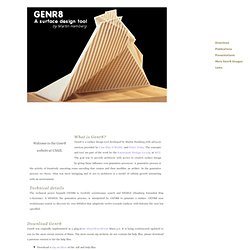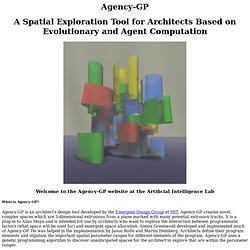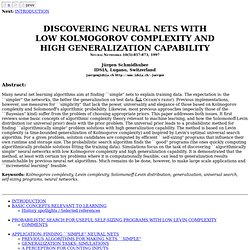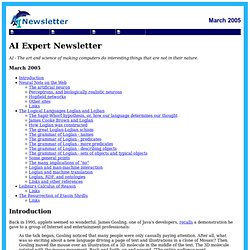

Hakia. GENR8. Technical details The technical power beneath GENR8 is twofold: evolutionary search and HEMLS (Hemberg Extended Map L-Systems).

A HEMLS, the generative process, is interpreted by GENR8 to generate a surface. GENR8 uses evolutionary search to discover its own HEMLS that adaptively evolve towards surfaces with features the user has specified. Using Genr8 Genr8 has been used at the EmTech programme at the Architectural Association since 2002. Genr8 was developed as a proof of concept that the combination of surface based L-systems and evolutionary algorithms could be useful for architectural design. The program has a large number of parameters.
Unfortunately, there is no modelling of the material or structural behavior in Genr8. Agency-GP AI Lab. Welcome to the Agency-GP website at the Artificial Intelligence Lab What is Agency-GP?

Agency-GP is an architect's design tool developed by the Emergent Design Group at MIT. Agency-GP creates novel, complex spaces which are 3-dimensional extrusions from a plane marked with many potential extrusion tracks. It is a plug-in to Alias Maya and is intended for use by architects who want to explore the interaction between programmatic factors (what space will be used for) and emergent space allocation. Simon Greenwold developed and implemented much of Agency-GP. The tool is based on genetic programming with an agent-based fitness evaluation. How do I understand the pretty image that's above? This is an outcome of an Agency-GP 'evolutionary run'. Want something more practical or that feels more like space?
If you started with a template that had linear tracks, you would get linear rather than curved spaces. Integrated Systems Laboratory. Neural Computation. P.A.U.L.A. Welcome to the official web site of P.A.U.L.A, the artificial intelligence with a more human touch.

In case you don't already know what this is all about - let me give you an explanation. P.A.U.L.A stands for Paolo's Artificial Intelligence Limited to Assimilation. UNIVERSALITY AND EMERGENT COMPUTATION IN CELLULAR NEURAL NETWORK. Fast Artificial Neural Network Library. An introduction to neural networks. DISCOVERING NEURAL NETS. Jürgen Schmidhuber IDSIA, Lugano, Switzerland juergen@idsia.ch Many neural net learning algorithms aim at finding ``simple'' nets to explain training data.

The expectation is: the ``simpler'' the networks, the better the generalization on test data ( Occam's razor). Previous implementations, however, use measures for ``simplicity'' that lack the power, universality and elegance of those based on Kolmogorov complexity and Solomonoff's algorithmic probability. Likewise, most previous approaches (especially those of the ``Bayesian'' kind) suffer from the problem of choosing appropriate priors. Keywords: Kolmogorov complexity, Levin complexity, Solomonoff-Levin distribution, generalization, universal search, self-sizing programs, neural networks. Artificial Neuron Applet.
Introduction This applet demonstrates the basic structure and behaviour of an artificial neuron.

Credits The original applet was written by Fred Corbett , and is available here . These pages and applet were modified by Olivier Michel and Alix Herrmann. Theory The first computational model for an artificial neuron was proposed by McCulloch and Pitts in 1943. The general artificial neuron model has five components, shown in the following list. Applet As you can see below, an artificial neuron is a very simple structure. AI Newsletter.
AI - The art and science of making computers do interesting things that are not in their nature.

March 2005 Introduction Back in 1995, applets seemed so wonderful. James Gosling, one of Java's developers, recalls a demonstration he gave to a group of Internet and entertainment professionals: As the talk began, Gosling noticed that many people were only casually paying attention. Ten years later, applets haven't become as popular as everyone hoped. Neural Nets on the Web More than symbolic AI, neural nets seem to lend themselves to applet demonstrations - perhaps because compared with trees, graphs, and other structures, displaying the output is relatively straightforward. The artificial neuron I did a lot of searching before starting to write. The original applet was written by Fred Corbett - link-rot has swallowed his page - and modified by Olivier Michel and Alix Herrmann.
The applet is embedded in the middle of a page which has some exercises below it, and a brief theory section above.